
Sacha Lichine tire sa révérence, pas ses vins
Par idelette Fritsch


Par idelette Fritsch


By Aggerant Llewellyn
Elizabeth Hurley was honoured for her 30 years as an ambassador for Estée Lauder’s Breast Cancer Campaign at a special Pink Ribbon dinner at NIJŪ in London on Monday.
The actress, 60, who was supported at the star-studded event by lookalike son Damian, 23, matched the evening’s colour scheme perfectly in a pink Rebecca Vallance midi dress.
Elizabeth’s stylish look was tailored to perfection and boasted statement bows as well as a a Bardot neckline which showcased her ample cleavage.
The Inheritance star added extra height to her slender frame with strappy heels while styling her highlighted tresses into loose waves.
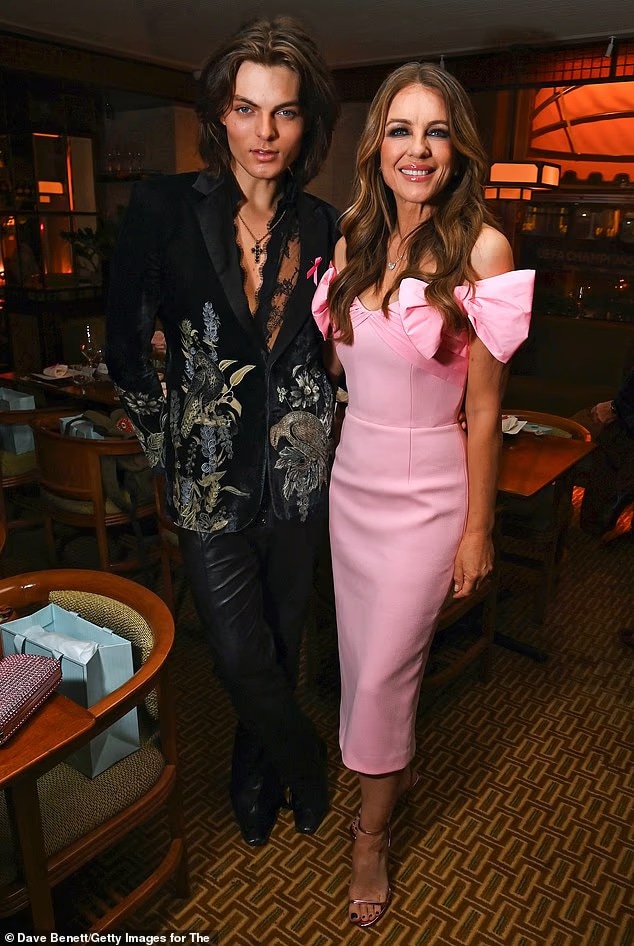
The evening was hosted by William P. Lauder, Chair of the Board of Directors for The Estée Lauder Companies, whose mother, Evelyn H. Lauder co-created the pink ribbon and started The Breast Cancer Campaign campaign in 1992.
It took place in the private dining room of NIJŪ the authentic Japanese restaurant from Executive Chef Chris Golding.
Guests sampled Lanson Le Rosé Creation and Wild Idol non-alcoholic sparkling rosé, before sitting for an elegant dinner paired with Chateau D’Esclans 2022.


By Michael Huband
While many drinkers are unsure of food pairings to match rosé, Château d’Esclans has suggested the perfect dishes to accompany its estate wines, from quiche to caviar.
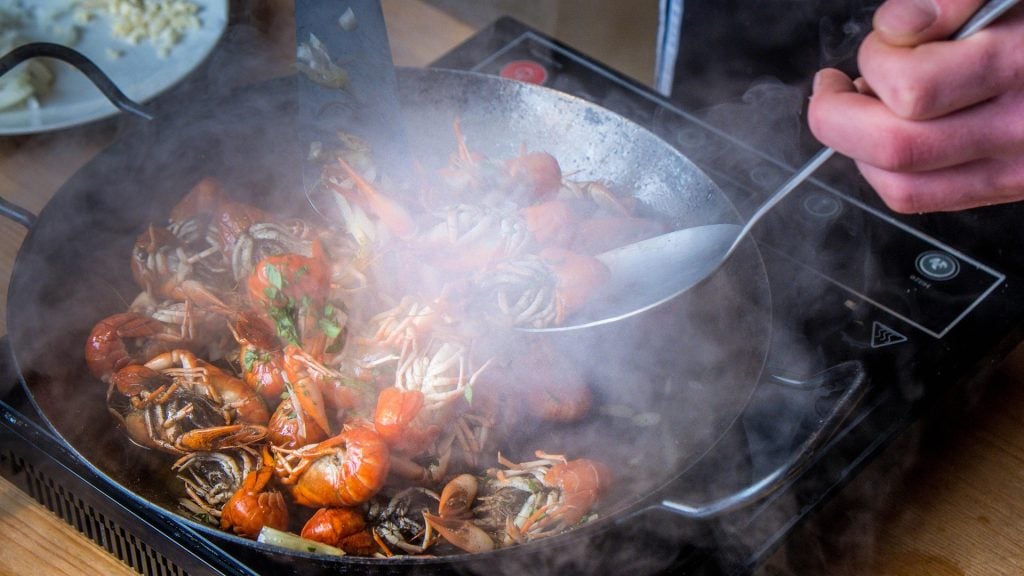
Rosé has been one of the wine industry’s great success stories of this century, and Provence rosé has been central to that. Between 2010 and 2022, exports of Provence rosé have more than quadrupled and their average value has doubled.
Moreover, the southern French region has become the benchmark for the category globally: consumers judge the competition in relation to Provence.
The appeal has certainly proved irresistible. But it has also frequently been simplified. Too often, Provence rosé is characterised as just a hot weather wine: crisp, inoffensive and made for sipping by the pool. It is a characterisation that the region’s best producers are now refuting.
Château d’Esclans is a prime example. Founded in 2006 by Sacha Lichine, it was born of a mission to create the greatest rosés in the world.
The property is situated northeast of St. Tropez, looking over valleys and, in the distance, towards the Mediterranean. It offers a perfect position to craft authentic, quality-driven rosé.
Alongside founding winemaker Patrick Léon, Lichine built a portfolio that embraced both Provence tradition and innovative winemaking. It includes a variety of styles – now sold in more than 100 countries – that show the breadth of potential for rosé in Provence.
Of course, in that range there are still refreshing wines to sip by the pool. Whispering Angel – a category leader – is far more complex than the stereotype, but it undeniably serves as a popular thirst-quencher.
Yet Provence rosé, as made by Château d’Esclans, showcases far more than freshness and drinkability. The estate wines, in particular, have gastronomic potential that drinkers sometimes overlook. So what is the pairing potential of the high end rosés? We spoke to the winemaking team for their recommendations.
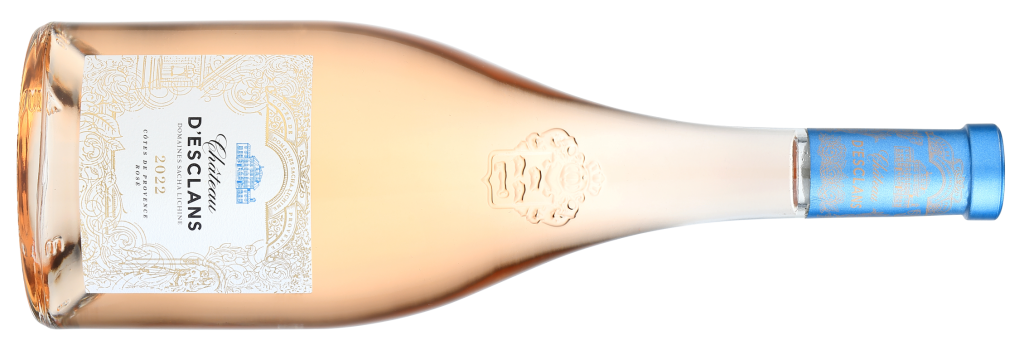
Made solely with grapes from the Château’s own vineyards, this estate wine brings together the approaches that define the winery.
Its blended Grenache and Rolle grapes are picked early in the morning, preserving freshness before the Provençal sun starts to heat the vines. They are then fermented in a mix of stainless steel and barrels, preserving the quintessential freshness while adding fullness and a smooth, creamy texture.
This complex wine is elegant and versatile, so the dishes it can accompany are likewise wide-ranging. Its winemakers recommend richer vegetarian dishes, such as ratatouille, quiche lorraine or a salad of apple, walnuts and goat’s cheese. Equally, Château d’Esclans can complement fresher meat-based dishes, like beef carpaccio or chicken with tomatoes, olives and lemon risotto.
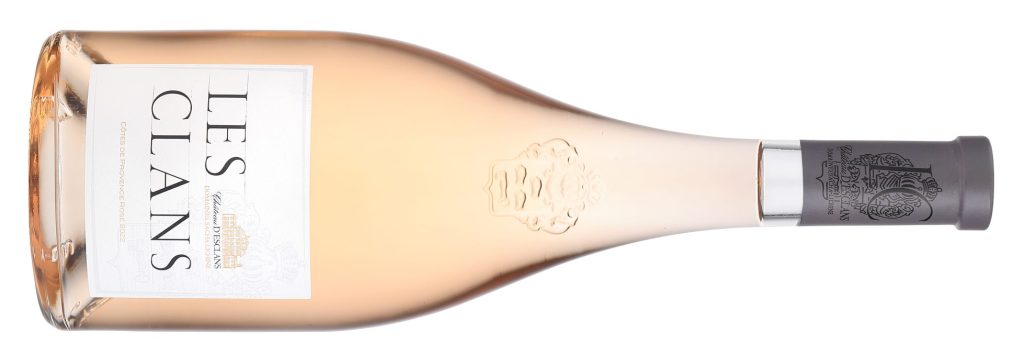
Though bearing the estate’s hallmarks, Les Clans marks a step-change in the gastronomic ambition of the range. Once again employing Grenache and Rolle, its winemaking is founded on principles of sophistication and richness.
In practice, that means 100% oak fermentation and maturation, using 600 litre temperature-controlled demi-muids. Twice weekly bâtonnage over its eleven months of ageing further builds its rich profile.
Lobster, sea bass ceviche and tuna tartare: the suggested pairings use Les Clans’ combination of body, elegance and exotic notes to complement richer servings of fish and sea food. It also, however, has the weight and balance to pair with French classics such as steak au poivre, cheese soufflé and terrine of foie gras.

The combination of outstanding vineyards and precise winemaking has made Garrus a benchmark for fine rosé. It is concentrated and creamy, with richness and spicy notes that evoke top Burgundy and prestige Champagne.
Given the ambition behind it, the winemakers recommend iconic French dishes. It can offer freshness against some of the finest dishes in the world, like caviar or goat’s cheese. It also works well against the buttery delicacy of grilled sole with beurre blanc.
However, this is not a wine confined to a world of Michelin stars. Garrus’ combination of freshness and richness makes it ideal for humbler dishes that might grace the table at a family gathering. It will complement a rack of lamb, côte de bœuf with béarnaise sauce or roast chicken and sautéed rosemary potatoes – a wine equally suited to silver service as to grand-mère and grand-père’s dining room.

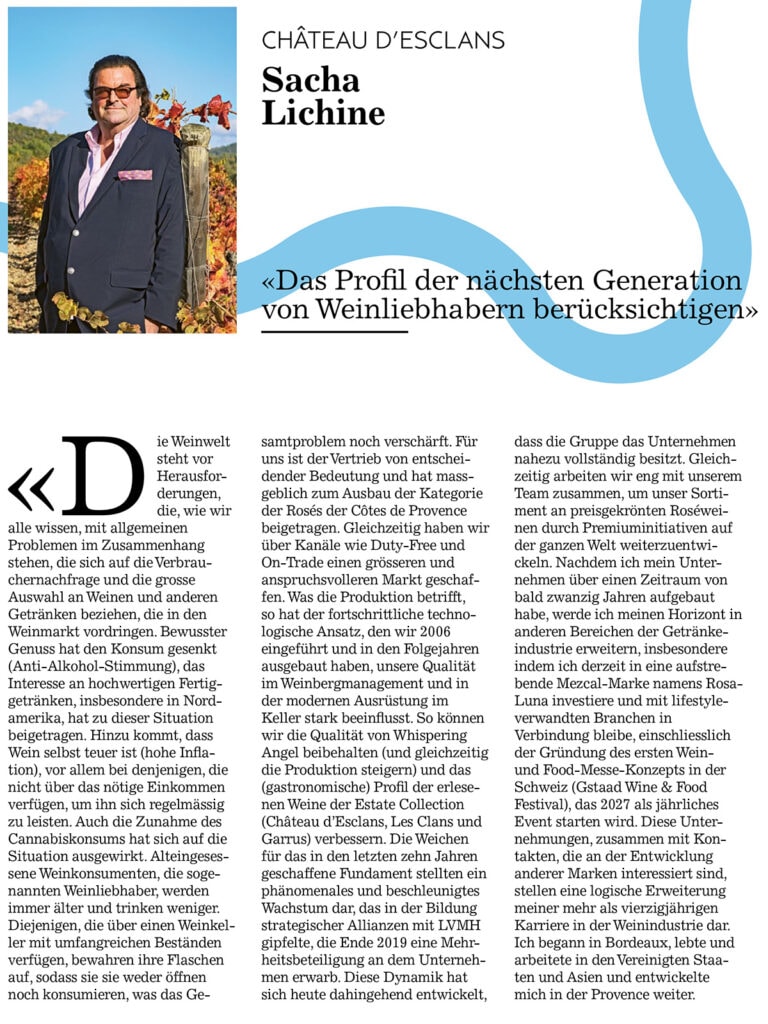
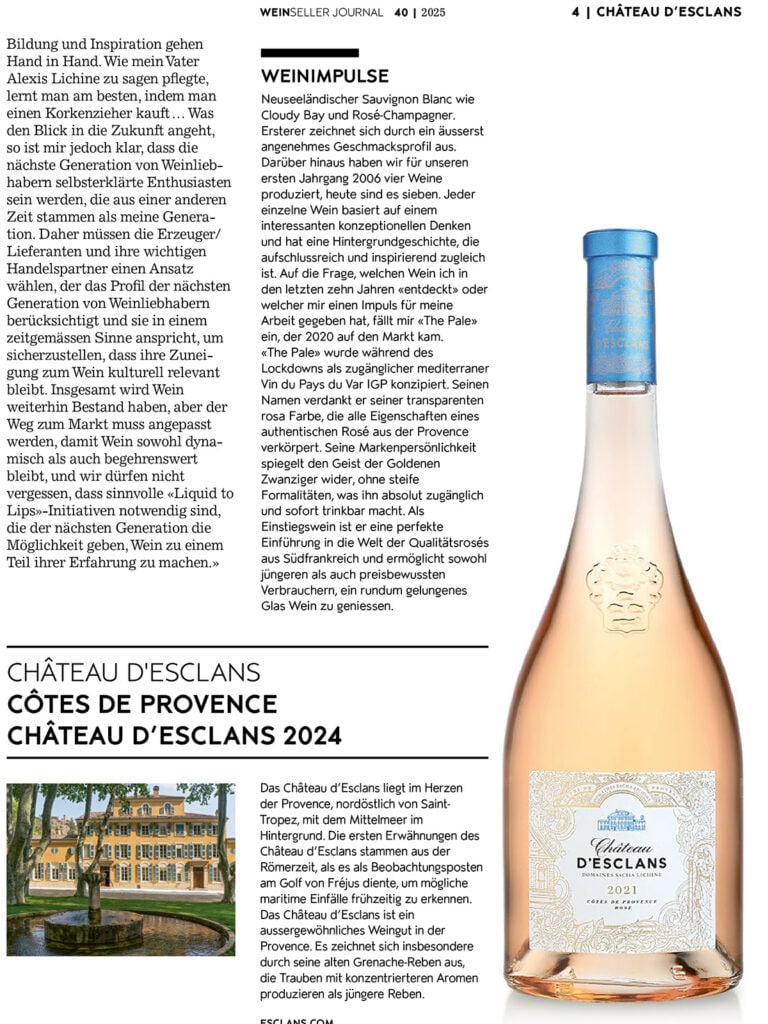
CHÂTEAU D’ESCLANS Sacha Lichine “Considering the Profile of the Next Generation of Wine Lovers” “The wine world is facing challenges that, as we all know, are related to broader problems related to consumer demand and the wide variety of wines and other beverages penetrating the wine market. Conscious drinking has reduced consumption (anti-alcohol sentiment), and interest in high-quality ready-to-drink beverages, particularly in North America, has contributed to this situation. In addition, wine itself is expensive (high inflation), especially among those who don’t have the income to afford it regularly. The rise in cannabis use has also affected the situation. Long-standing wine consumers, the so-called wine lovers, are getting older and drinking less. Those with a wine cellar with extensive stocks are storing their bottles, so they neither open nor consume them, which exacerbates the overall problem.
Distribution is crucial for us and has contributed significantly to the expansion of the Côtes de Provence rosé category. At the same time, we have created a larger and more demanding market through channels such as duty-free and on-trade. Regarding production, the advanced technological approach we introduced in 2006 and expanded in subsequent years has greatly influenced our quality in vineyard management and modern equipment in the cellar. This allows us to maintain the quality of Whispering Angel (while increasing production) and enhance the (gastronomic) profile of the fine wines in the Estate Collection (Château d’Esclans, Les Clans, and Garrus).
The foundation laid over the past decade has set the stage for phenomenal and accelerated growth, culminating in the formation of strategic alliances with LVMH, which acquired a majority stake in the company at the end of 2019. This momentum has now evolved to the point where the group owns the company almost entirely. At the same time, we are working closely with our team to further develop our range of award-winning rosé wines through premium initiatives around the world.
Having built my company over a period of almost twenty years, I will be expanding my horizons into other areas of the beverage industry, notably by currently investing in an emerging mezcal brand called Rosa-Luna and staying connected with lifestyle-related industries, including the creation of the first wine and food fair concept in Switzerland (Gstaad Wine & Food Festival), which will launch as an annual event in 2027. These ventures, along with contacts interested in developing other brands, represent a logical extension of my more than forty-year career in the wine industry. I began in Bordeaux, lived and worked in the United States and Asia, and continued my development in Provence. Education and inspiration go hand in hand.
As my father, Alexis Lichine, used to say, “The best way to learn is to buy a corkscrew…” Looking ahead, however, it’s clear to me that the next generation of wine lovers will be self-described enthusiasts who come from a different era than my generation. Therefore, producers/suppliers and their key trade partners must take an approach that considers the profile of the next generation of wine lovers and speaks to them in a contemporary way to ensure their affection for wine remains culturally relevant.
Overall, wine will continue to exist, but the route to market must adapt to ensure wine remains both dynamic and desirable, and we must not forget the need for meaningful “liquid to lips” initiatives that give the next generation the opportunity to make wine part of their experience.
New Zealand Sauvignon Blanc such as Cloudy Bay and rosé champagne. The former is characterized by a highly pleasing flavor profile. In addition, we produced four wines for our first vintage in 2006; today there are seven.
Each wine is based on interesting conceptual thinking and has a backstory that is both insightful and inspiring. When asked which wine I have “discovered” in the last ten years or which has given me an impulse for my work, “The Pale” comes to mind, which was released in 2020. “The Pale” was conceived during the lockdown as an accessible Mediterranean Vin du Pays du Var IGP. It owes its name to its transparent pink color, which has all the characteristics of an authentic Rosé from Provence embodies this. Its brand personality reflects the spirit of the Roaring Twenties, without stiff formalities, making it completely accessible and immediately drinkable.
As an entry-level wine, it is a perfect introduction to the world of quality rosés from the South of France, allowing both younger and price-conscious consumers to enjoy a thoroughly enjoyable glass of wine.
CHÂTEAU D’ESCLANS CÔTES DE PROVENCE CHÂTEAU D’ESCLANS 2024 Château d’Esclans is located in the heart of Provence, northeast of Saint-Tropez, with the Mediterranean Sea as its backdrop. The first mentions of Château d’Esclans date back to Roman times, when it served as an observation post on the Gulf of Fréjus to detect possible maritime incursions early on. Château d’Esclans is an exceptional winery in Provence. It is particularly distinguished by its old Grenache vines, which produce grapes with more concentrated aromas than younger vines.

London’s exclusive hotels and restaurants have worked tirelessly to open charming outside spaces.
By Jasmine Boothe-Henry and Kim Ayling
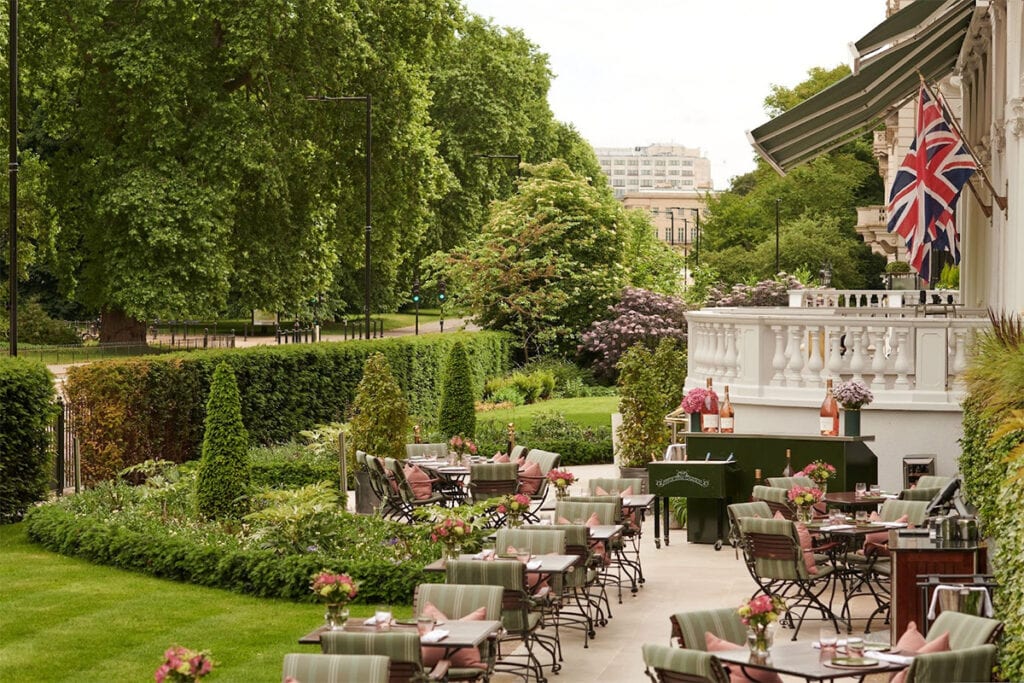
Dinner by Heston Blumenthal’s pretty outdoor terrace might not have the city-sweeping views of London’s rooftop bars but, thanks to its location right on Hyde Park, it has a pretty special backdrop of its own.
Open for lunch during the day and snacks in the evening, the menu takes cues from the main Heston Blumenthal restaurant inside, with quirky takes on British classics: fish and chips, coronation chicken, and Eton mess. And yes, the chef’s famed Meat Fruit dish is on offer. Wash it all down with a glass of Château d’Esclans’ rosé.


The Fifty Best held a “blind” tasting of 13 recent release Rosé wines with eight members of our wine judging panel. The order of service was established beforehand by lottery. Strict tasting rules were applied. Each of the wines were poured into fresh glasses from new sealed bottles and served well chilled. Only ice water and crusty peasant bread were available to cleanse the palate.
The judges wrote down their impressions of each wine on score sheets. The scoring was based on a 5-point system, with 5 as the highest. Double Gold, Gold and Silver medals are awarded according to a set range of final point scores received from the judges. There were no Bronze medals awarded for this tasting. Medals are provided based entirely on merit and only to products judged worthy of such award.
The tasting notes that follow are summaries of the judges’ opinions, with all replicated commentary eliminated. The states and countries are identified for each brand.
Château d’Esclans Rosé 2023
(Domaines Sacha Lichine, Côtes de Provence, FR)

Aroma: Strawberry, crabapple, rhubarb, lemon juice, citrus, white flowers, wet stone, sunshine in Provence.
Palate: Nectarine, sweet peach, strawberry, blackberry, red plum, rose petals, honeysuckle, soft mineral, nice tannins, tangy, rich.
Finish: Peach, crabapple, lemon-lime, citrus, mint, thyme, mineral, big, balanced, classic style, near perfect.
Double Gold Medal

Whispering Angel Rosé 2024
(Côtes de Provence, FR)

Aroma: Strawberry, pomegranate, crabapple, apricot, blood orange, melon, pink grapefruit, minerality, wet stone.
Palate: Strawberry, raspberry, black raspberry, tart cherry, rhubarb, yellow peach, blood orange, grapefruit, lemon, mint, white flowers.
Finish: Crabapple, yellow peach, citrus, mineral, wet stone, balanced, tangy, crisp, lively, enjoyable.
Gold Medal


Capturing the Lavender Fields
By Vito L Tanzi
Capturing the Lavender Fields
There’s a certain kind of light in Provence that feels almost mythical—soft, golden, and endlessly flattering. It’s the same light that drew Van Gogh to Arles and Cézanne to Aix, that spills across lavender fields in July and casts long shadows through olive groves in the Luberon. But you don’t have to be a painter to fall for it. For photographers and travelers alike, Provence offers a canvas of color and texture unlike anywhere else in France. Plus, the food in the south of France is simply amazing.

This is a place where time seems to stretch. Mornings begin with the slow bustle of open-air markets, afternoons drift past vineyards and ochre-hued villages, and evenings end with golden hour glowing on stone façades. I would definitely stop at every open-air market that you run into. You will buy incredibly delicious fresh cheese, wines, and the best produce.

Provence, in the southeastern part of France, is renowned for its picturesque villages, rolling vineyards, and, most famously, its stunning lavender fields. Each summer, these fields burst into bloom, painting the landscape with hues of purple and attracting visitors from all over the globe.
In this guide, I’ll share some of my favorite places to stay, eat, and photograph across the region. Whether you’re coming for the lavender or the rosé, the Roman ruins or the Mediterranean light, Provence offers inspiration for everyone.
5. Rosé Wine
More a lifestyle than a drink in Provence. Light, dry, and perfect with basically anything you eat in the region. Try a bottle from Château d’Esclans


Spread the love

From centuries-old vineyards high in Provence, Château d’Esclans has reinvented rosé wine with elegance, character and vision, creating a category of its own: luxury rosé.
Just an hour from the glamorous Côte d’Azur, between Saint-Tropez and Cannes, hides a place where rosé wine has reached new heights of sophistication: Château d’Esclans. This winery, located in the heart of the Var, is not only a pioneer in the creation of luxury rosés, but has completely redefined the perception of rosé in the world.
A HISTORY WITH MILLENNIAL ROOTS AND A VISION OF THE FUTURE
The Château d’Esclans vineyard sits on land that has been cultivated for more than 2,500 years. On top of a hill, the ruins of an ancient Roman watchtower that guarded the Gulf of Fréjus still remain. But it was in 2006 that the real change began: Sacha Lichine, son of the legendary Alexis Lichine, acquired the château and decided to revolutionize rosé, giving it the category of the great wines of the world.
A PASSIONATE AND EXPERT TEAM
The success of Château d’Esclans would not be possible without the figure of winemaker Bertrand Léon, heir to the savoir-faire of his father Patrick Léon, one of the great names in French wine. Bertrand has perfected the balance between tradition and modernity, working with surgical precision to maintain excellence in each vintage.
At his side, cellar master Jean-Claude Neu, who has been at the helm of the process since 2006, ensures that each bottle is the result of craftsmanship, from the optical selection of the grapes to the aging in oak barrels.
HARVESTING BY HAND, TECHNOLOGICAL PRECISION, SENSORY EXCELLENCE

The grapes, mostly Grenache and Rolle (Vermentino), are hand-picked at dawn to preserve their freshness. Subsequently, they go through a rigorous system of manual and optical selection, followed by vinification at a controlled temperature and without maceration, which extracts only the purest juice.
In the winery, the process is meticulous: fermentations in stainless steel and in 600L oak demi-muids, Burgundy-style “bâtonnage” and barrel aging for the high-end wines. All with a single objective: to create rosés that are fine, complex and absolutely memorable.
A LUXURY ALLIANCE WITH LVMH
International recognition was not long in coming. In 2019, the luxury giant LVMH acquired 55% of Château d’Esclans, betting on this project as a global benchmark for high-end rosé wine. This strategic alliance has boosted its expansion into key markets in Asia, America and Europe, positioning Château d’Esclans as a new emblem of French lifestyle.
WINE AND GASTRONOMIC DESTINATION
Château d’Esclans is not just a winery, it is an experience. Its natural environment, its thousand-year-old history and its architecture make each visit a journey through time and the senses. An ideal destination for lovers of wine, culture, design and gastronomy.

Our roundup of the top Easter brunches and celebrations around Miami is still live and being updated in real time.
MAKOTO
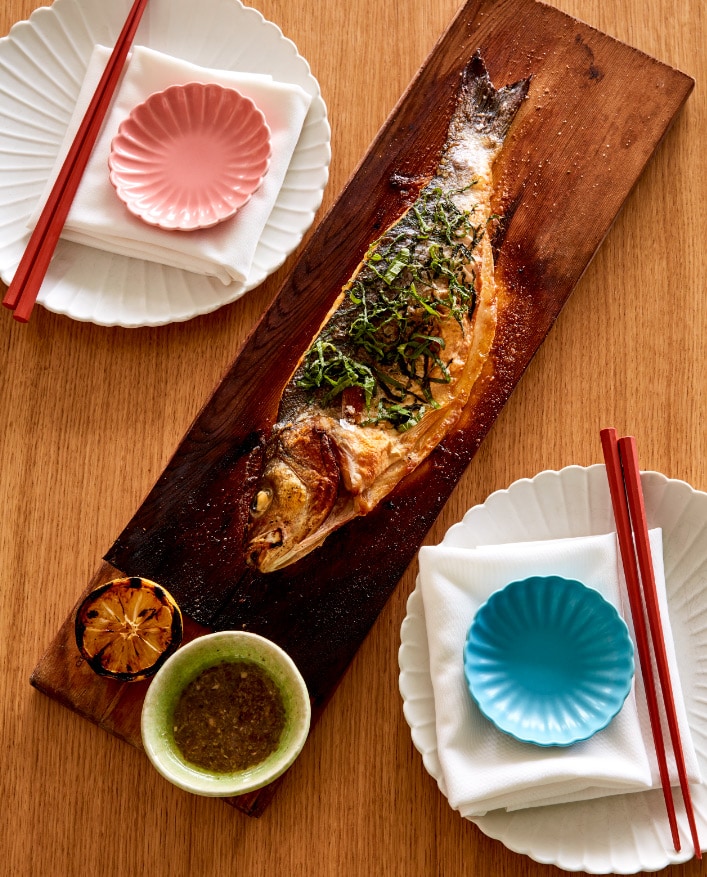
Description: This Easter, Makoto is elevating the holiday with exquisite specials. Indulge in the Dry-Aged Ceviche, featuring caviar, myoga, wakamomo, yuzu, and hanaho, or savor the 48-Hour Wagyu Short Rib, served with jumbo asparagus and a bold peppercorn sauce. Complement your meal with vibrant seasonal sips, including the Clarified Piña Colada and the floral-infused Hibiscus Margarita. For those looking to explore sake, curated flights Nigori Experience and Dassai Experience offer a taste of Japan’s finest brews. Elevate the celebration with a selection of fine wines, from Château d’Esclans Rosé to Raen ‘Lady Marjorine’ Chardonnay.

Address: Bal Harbour Shops 9700 Collins Ave Miami Beach, FL 33154

The American Academy in Rome honors two figures whose work in medicine and cinema continues to shape conversations across disciplines and borders
By Monica Straniero

On June 4, the American Academy in Rome will present the McKim Medal to Virgilio Sacchini and Giuseppe Tornatore. The ceremony will take place at Villa Aurelia, just before sunset, in the same building that has housed the Academy on the Janiculum Hill since 1909. The award, which each year honors Italian figures who have contributed to the cultural dialogue between Italy and the United States, is not just about representation. It recognizes people whose work has built real bridges, across time, disciplines, and borders.
Sacchini is an oncologic surgeon with a long history of working in breast cancer prevention. Over the years, he has moved between France, Italy, and the United States, dividing his time among hospitals, research centers, and internat onal study groups. At Memorial Sloan-Kettering in New York, he has collaborated with organizations such as the EORTC (European Organization for Research and Treatment of Cancer), the NASBP (National Surgical Adjuvant Breast and Bowel Project), and the RTOG (Radiation Therapy Oncology Group), helping to develop new approaches in chemoprevention and radiation therapy. In his research, cancer is never treated as just a disease. It is a social issue, one that involves patients, families, and the healthcare systems responsible for deciding who receives care—and how.
Tornatore received an Academy Award in 1990 for Nuovo Cinema Paradiso, a film about childhood, cinema, and life in small southern towns. Since then, he has continued to explore themes of memory, time, and family, directing films such as Malèna, Baarìa, The Best Offer, and Ennio. His work has involved collaborations with actors including Philippe Noiret, Monica Bellucci, Marcello Mastroianni, and Geoffrey Rush, and has maintained a strong connection to the places and emotional landscapes that shaped his vision.
The Gala is more than a celebration of two careers. It is also a moment for supporting the Italian Fellowships, the Academy’s grants reserved for Italian artists and scholars. The program is unique among foreign academies in Rome and, over the years, has allowed many different kinds of research and creative practices to take shape in a shared space.
Presiding over the evening will be Beatrice Bulgari, who has long been active in projects at the intersection of art, cinema, and cultural production. She will be joined by Academy President Peter N. Miller, Director Aliza S. Wong, Board Chair Calvin Tsao, and Honorary Gala Chairs Ginevra Elkann, Margherita Marenghi Vaselli, Carla Markell, and Maria Teresa Venturini Fendi. The evening will also include a reception—informal, but thoughtfully curated. Wines will be offered by Paolo and Noemia d’Amico and Château d’Esclans, while cocktails will be created by Quattro Gatti Gin.
Founded in 1894, the American Academy in Rome is the oldest U.S. cultural institution operating abroad. It has hosted hundreds of artists, architects, and scholars over the decades, many of whom have gone on to receive major awards such as the Nobel, Pulitzer, MacArthur, and Pritzker. Today, through its residency programs, exhibitions, lectures, and public events, the Academy remains a space where disciplines meet and conversations unfold over time. On the evening following the Gala, June 5, the Academy will open its doors to the public for the annual Open Studios, offering a chance to explore the work created by the current fellows during their time in Rome.

Address: Bal Harbour Shops 9700 Collins Ave Miami Beach, FL 33154